Kwiziq

Summary
Kwiziq is a language-learning platform offering courses in Spanish and French with a curriculum centered around quiz-like exercises. There are plenty of grammar lessons that accompany these quizzes as well as some writing and listening practice opportunities. It isn’t the most fun resource to use, and it makes the most sense for learners that are especially interested in grammar.
The interface is pretty easy to use and the material is high-quality, but the content and exercises aren’t engaging.
Grammar explanations and quiz feedback are impressive, but the exercises are limited.
There are less expensive resources out there, but this platform could be right for some people.
I Like
- The test feedback is detailed and useful
- The writing practice is effective
I Don’t Like
- The practice opportunities aren’t varied
- Grammar lessons offer explanations but little practice
- The reading practice is limited
Price
The basic account is free, and a premium package is available for the following monthly subscription options:
$22.79/month $56.97/three months $122.29/year $227.76/two years
Are you a good test-taker? Tests stress some people out; others love to see how well they can perform. This resource certainly appeals to the latter.
Kwiziq is a resource designed for the grammar-loving quiz fan. Using the resource revolves largely around taking “kwizzes” and learning from in-depth grammar lessons to get better scores.
There’s a lot of good material in these grammar lessons, but you’ll have to bring your own enthusiasm — they aren’t exactly eye-catching.
While there aren’t videos or pictures or much in the way of exercises that aren’t fill-in-the-blank questions, the resource provides a ton of feedback and information regarding your progress in learning the language.
If you love data and are interested in seeing exactly how well you’re performing in certain areas of the language, Kwiziq delivers. It’s also got some nifty writing and listening practice.
I don’t think this one makes a ton of sense for learners just starting out with a language, and there are less expensive alternatives, but Kwiziq stands out enough that I could see it especially appealing to some.
Placement Test
The first thing you’ll do after signing up for Kwiziq is take a placement test. This test is quite thorough (there are 53 questions for the Spanish test), but it doesn’t test your listening or speaking skills.
The questions start out easy and then get harder as you progress. The idea is that you answer all that you can and skip the rest.
Placement tests aren’t uncommon in language learning resources and are a good sign for anyone that isn’t an absolute beginner in a language. A good placement test should be able to make your study time much more efficient by figuring out exactly where you’re at and what you should be studying.
One thing that stood out to me about this placement test is that there are often hints and translations given to help you with questions.

I think translations can be useful sometimes in order to avoid any ambiguity, but these hints sometimes felt extra helpful. I’m not sure if this had a big impact on the results, but I thought it was interesting.
After you’ve made it through all 53 questions, you get your CEFR level placement. I was placed at B2, which feels more or less accurate.
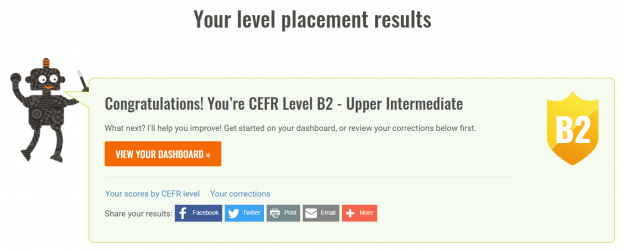
The really cool part is the detailed feedback you get from your test results. With other resources I’ve tried, some tests don’t even tell you which answers you got wrong, which I find frustrating, and others simply show you the correct answers to the ones you missed.
Kwiziq goes a step further and really breaks it down.
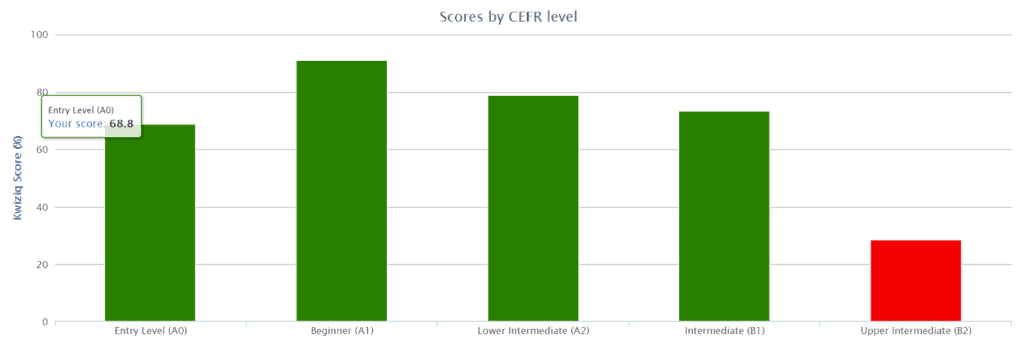
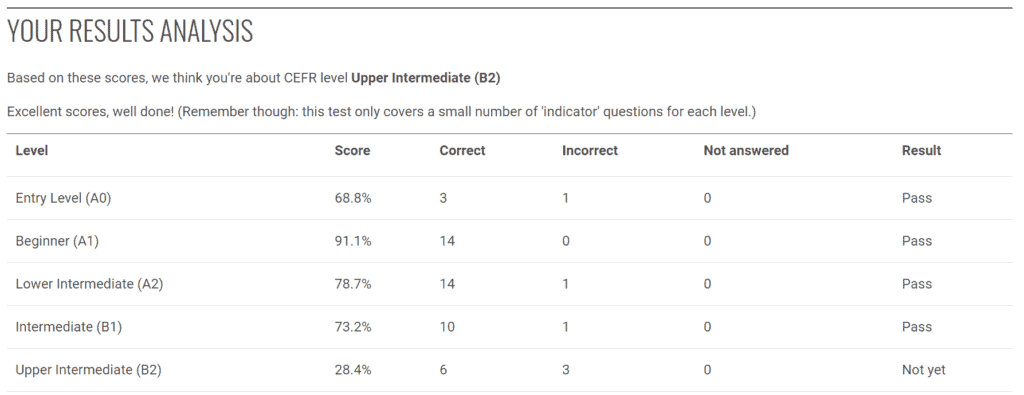
Statistics lovers, rejoice! Tables, graphs, and detailed information about your performance are available here, and I think it’s really valuable.
In addition to the snazzy results-analysis, you can also get worthwhile information about each question.
For example, I was confused about question number 47 in the quiz.

Here I can see my answer and the correct answer. I can also listen to an audio recording of the sentence in question. In this case, I wasn’t sure why my answer was incorrect.
Clicking on the ‘Explain This’ button leads you to a mini-lesson on the relevant grammar point. I was able to use this explanation to learn from my mistake and reach a better understanding. Pretty neat.
Kwizzes
The placement test is actually a great snapshot of the Kwiziq experience. All of the kwizzes that you take in the program follow the same format and provide similar feedback upon completion.
You can access kwizzes in one of two ways. The first is to take the recommended test that appears at the top of the dashboard screen.

By selecting the big orange button, you’ll begin a test that the program’s A.I. thinks is best for your level.
The other option is to take a test focused on a specific CEFR level.
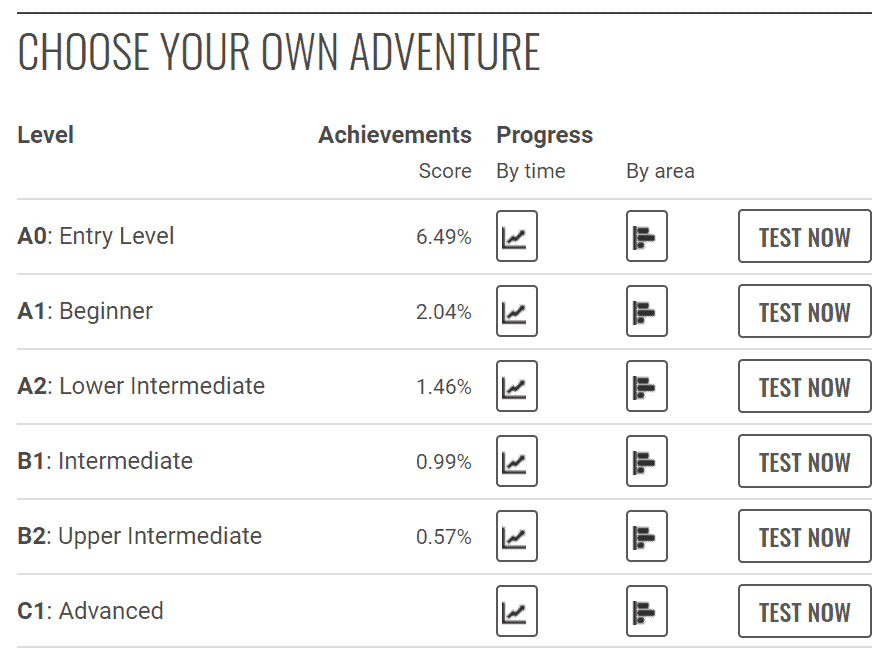
To start, I chose to take the recommended test. The question layout is exactly the same as in the placement test. Multiple-choice or fill-in-the-gap questions with the odd hint here and there.
Afterward, I got my first award.
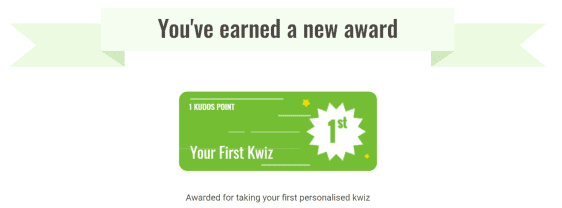
There are a bunch of these you’ll come across through normal use of the program.
After claiming your award, you get to see your results. I didn’t actually perform that well, but the detailed feedback was very much appreciated.
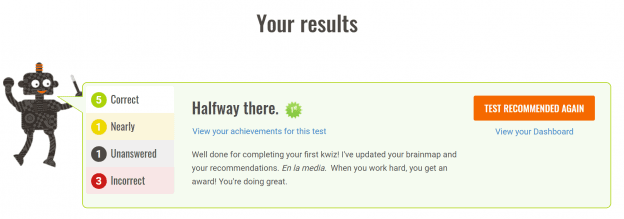
After this, you get the same type of feedback we saw in the placement test. You can see all of the correct answers to questions and access explanations for any you missed.
Kwiziq Lessons
Thankfully, Kwiziq does more than just test you on the language relentlessly. It also has lessons to help you improve your weak points.

Your Studyplan is a group of 10 lessons that cover the language points you need to improve upon. You can study each of these individually and take a test including material from all of them.
I started with the first lesson on the list.
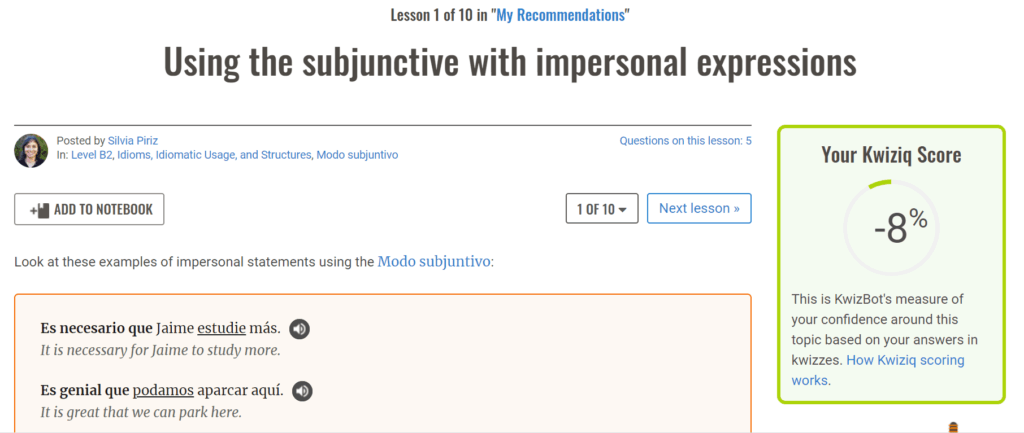
The lessons are full of examples and some good explanations. There are also lists of exceptions and relevant examples when necessary.
Things are color-coated and laid out nicely, which is important for anything trying to teach something as potentially boring as grammar.
There aren’t any practice opportunities in the lessons, however, which is a shame. At the end of the lesson, there’s a mini-kwiz consisting of just two questions.

Careful, basic account users! These mini-tests count toward your monthly limit of ten.
Completing this two-question test will have a direct effect on your Kwiziq Score for the topic. I think this resource would be much more valuable and effective at teaching language topics if the lessons were more interactive.
Instead, it seems that all of the practice happens in small tests.
Brainmap
The Brainmap is supposed to provide a visual, interactive representation of your progress in the language you’re learning.
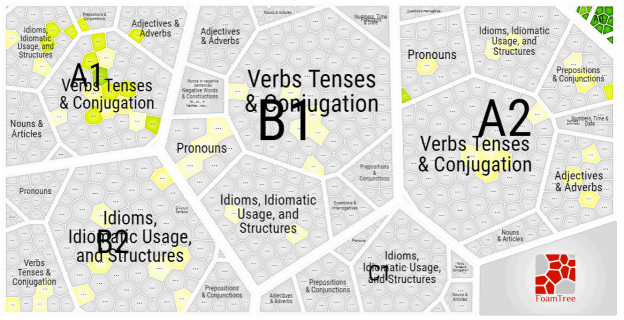
This video made by Kwiziq does a good job explaining this feature.
Essentially, the different cells change color based on how proficient you are in specific language points. You can zoom in and out to see what each cell represents, and clicking on a cell brings you to a relevant lesson for focused study.
While there might not be that much utility in the feature, it is kind of a cool way to be able to visualize your progress. It’s also something that becomes more useful the longer you use the resource. You’ll be able to see the weak points in what you’ve studied, and it’s satisfying to see cells turn green.
Listening Practice
The listening practice takes the form of a dictation exercise in Kwiziq. I tried out one of the examples at the A2 level to test it out. It’s titled, “En los brazos de Morfeo.”

Before beginning the dictation exercise, you’ll get to see a synopsis of the audio you’re going to listen to as well as some key words that you’ll hear. You also listen to the entire piece of audio before listening to smaller portions individually.
It’s helpful to listen to the entire audio once through to get a better understanding of the context. After you’ve listened to the whole thing, you’ll go piece by piece, transcribing short phrases.
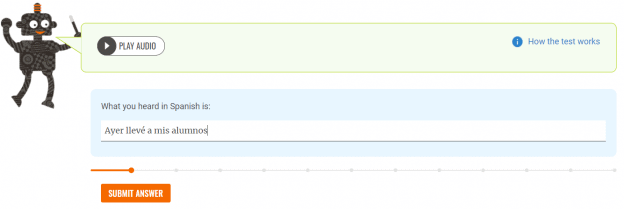
The phrases you’re asked to transcribe are all very short, and there are sometimes hints to help you with tricky words.
Immediately after submitting your answer, you’ll get to compare it with the correct answer and give yourself a self-assessment. You’ll also be able to see any of the relevant Kwiziq lessons.
After transcribing the entire audio recording, you’ll see your overall score and have access to all relevant lessons and material.
I think these dictation exercises are a pretty good way to practice listening. The opportunities for listening practice would be even better if there were listening comprehension exercises.
Reading Practice
Unlike with the listening practice, there are no exercises in the Kwiziq reading practice. Instead, practice is self-directed with the help of translations.
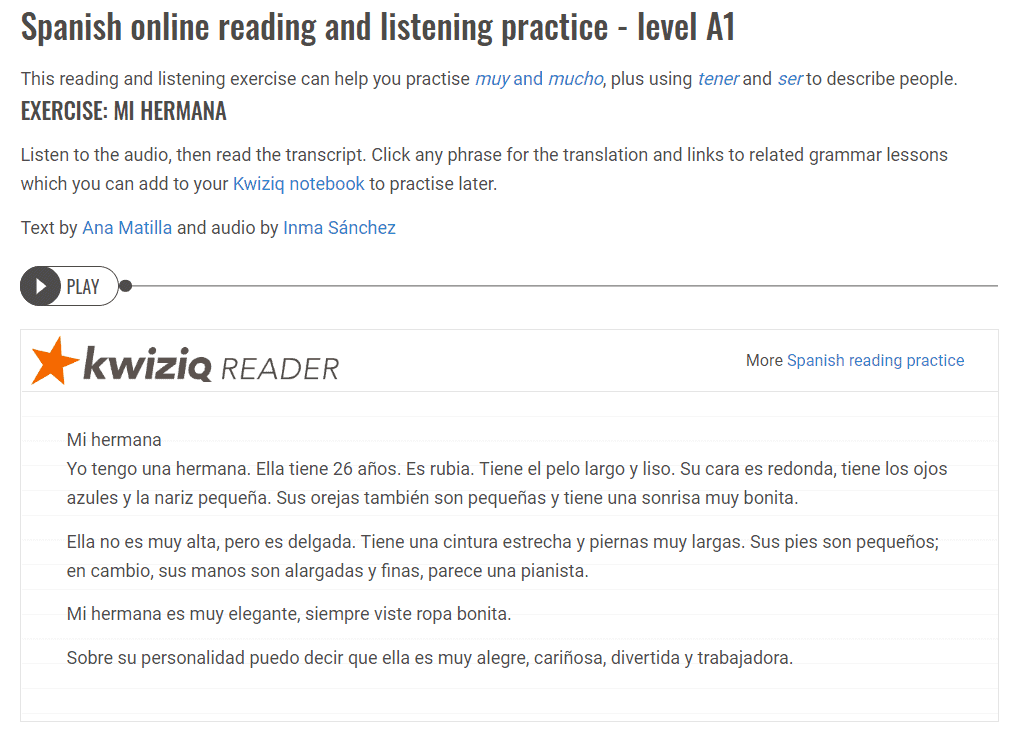
As you can see in this example, each piece of reading has a grammar focus. The idea is that you try to get through the reading on your own, clicking on phrases you don’t understand to get translations. You can also listen to an audio version of the text.
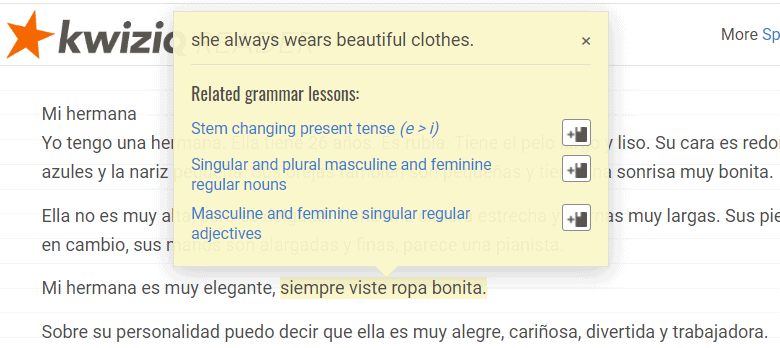
The text is pre-divided into translatable phrases. Clicking on one of them shows the English translation as well as links to the related grammar lessons.
It’s nice to have reading texts for practice with accurate translations and links to relevant grammar lessons, but it would be nice if there were additional ways to interact with the material.
Speaking Practice
Aside from speaking with another human via one-on-one lessons or language exchange, getting practical speaking practice can be difficult. Kwiziq doesn’t offer either of these solutions, but it doesn’t beat around the bush either.
Opportunity for practicing speech with Kwiziq is limited to listening to and repeating audio. The speaking practice section of the website instead tries to offer information regarding the best way to practice speaking skills and even points users in the direction of other resources where they can get good speaking practice.
Among other things, it recommends some free and paid resources where learners can practice with real people and gives tips for those that want to practice on their own or go about finding other people to practice with. It also offers general notes on what it means to be fluent and gives some resources for practicing pronunciation.
Kwiziq definitely isn’t the best place to practice your speaking skills, but the amount of information they have on different ways to practice is refreshing. It’s all well written and doesn’t feel like a sales pitch.
Writing Practice
The number of resources out there that provide good writing practice is unfortunately low. I think this is partly because good writing feedback typically requires input from a human. The Kwiziq solution to this is something I haven’t seen before, and I like it.
The writing practice here gets you to translate a text passage, one prompt at a time. You get to see the correct translations as you go and self-assess every answer you give.
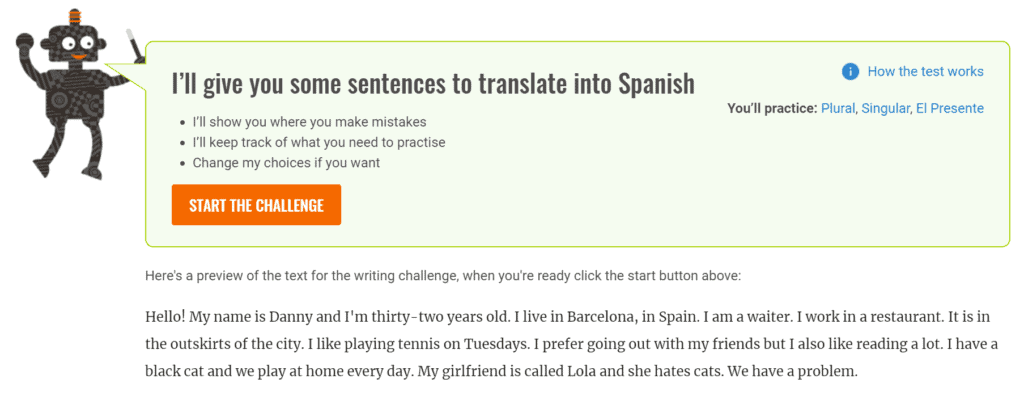
Here you can see the full text that you’ll be translating. Fortunately, the exercise only asks you to translate small portions at a time and gives immediate feedback.
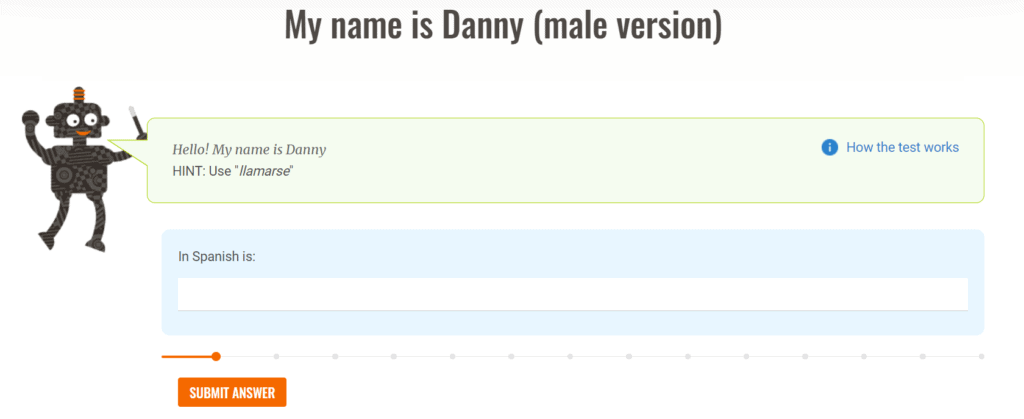
This is the general size of the prompts you’ll be asked to translate. The only full sentences I translated at this level (A2) were very small.
After submitting your answer, you’ll see yours compared with the correct answer.
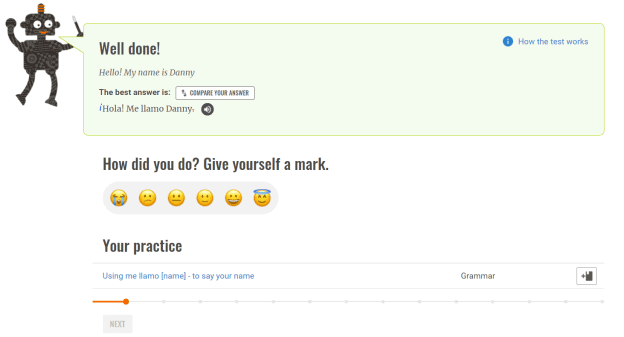
Then, depending on your performance, you give yourself a score for the individual translation prompt. In this case, my only mistakes were punctuation-related and I decided to give myself full credit.
You can also see the relevant grammar lesson for every prompt. This is handy if you’re feeling confused about the answer.
Once you’ve translated the entire text, bit by bit, you’ll get your final score and get to see the full translated text. You can also listen to the audio of the text which is done with text-to-speech technology.
Pricing
A free membership to Kwiziq gives you access to 10 kwizzes per month as well as a ton of grammar lessons. This is enough to give the resource a try, but it isn’t enough to use it seriously.
You also won’t have access to the Brainmap or the listening and writing practice activities.
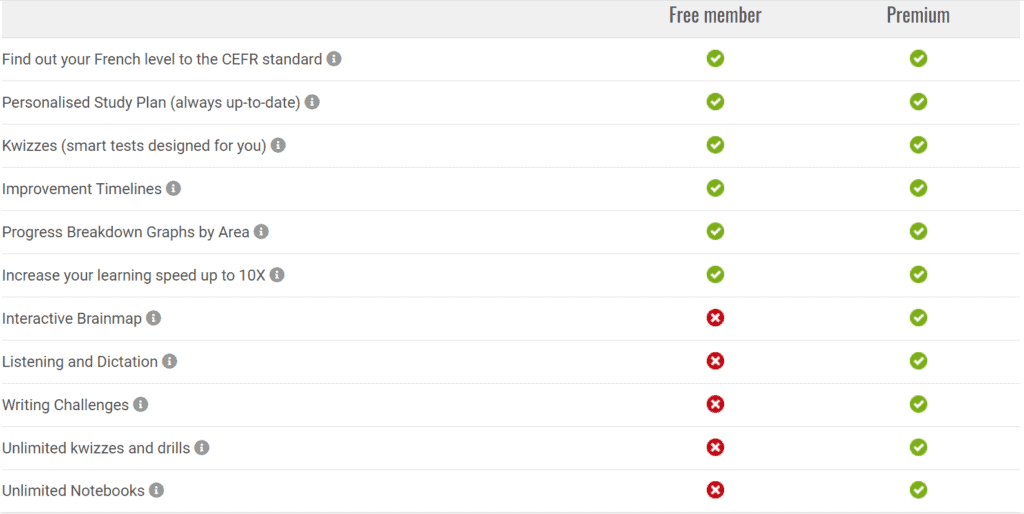
For premium membership and all of the features, you’ll have to pay a recurring subscription.

Alternatives
If taking quizzes is something you’re particularly interested in, StudySpanish has some good verb conjugation practice that’s free to use.
For learners interested in getting the speaking practice that’s lacking in Kwiziq, there are some good options out there.
Pimsleur is one that gets users to start speaking right out of the gate. It’s quite different from Kwiziq — there’s no emphasis on grammar whatsoever.
Other options include online teacher directories where users can find one-on-one lesson options. italki is one of the best. It’s got teachers of all qualifications and price levels as well as some chances for extra language exchange practice and writing feedback from actual humans.
Another place to look for one-on-one language lessons online is Verbling. It’s got stricter requirements for its teachers, something that’s reflected in the higher prices.
For additional pronunciation practice, it’s worth checking out Speechling. This site lets users submit recordings of themselves speaking to be evaluated by native speakers. It’s free to use! A paid membership unlocks the ability to submit as many recordings per month as you like.
Final Thoughts
Kwiziq isn’t the most engaging resource out there. The method it uses is based on learning through quizzes and reading about the answers you get wrong in order to learn from them.
As you take more quizzes, the program updates a tailored “Studyplan” based on your needs and provides detailed feedback on your learning progress. I think this is cool, but I’m not a big fan of using it as a primary study method.
It’s just not that rewarding or interesting to take a bunch of multiple-choice and fill-in-the-gap tests. If there were activities that were more interactive, videos, or even pictures, this resource would be more compelling.
As it is, I think Kwiziq is a good option for advanced learners that want to pinpoint some weak points in their language proficiency. It’s also better suited for those that have a strong desire to learn grammar and to be grammatically correct. The focus of the material is on accuracy more than communication.
For those looking for more language learning resources, be sure to check the table below for our favorites in some of the most popular languages.

